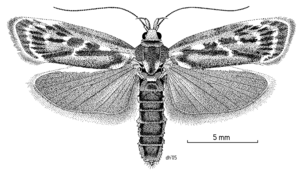Titirangi Tyger facts for kids
Quick facts for kids Titirangi Tyger |
|
|---|---|
 |
|
| Scientific classification | |
| Kingdom: | |
| Phylum: | |
| Class: | |
| Order: | |
| Family: |
Oecophoridae
|
| Genus: | |
| Species: |
H. tygris
|
| Binomial name | |
| Hierodoris tygris Hoare, 2005
|
|
The Hierodoris tygris, also known as the Titirangi Tyger, is a type of moth. It belongs to the family Oecophoridae. This moth is special because it is endemic to New Zealand, meaning it's found nowhere else in the world. The New Zealand Department of Conservation says this species is "Not Threatened," which is good news!
Contents
About the Titirangi Tyger Moth
How Scientists Named This Moth
This moth was first officially described in 2005 by a scientist named Robert J. B. Hoare. He gave it the scientific name Hierodoris tygris. The very first specimen of this moth that scientists studied was collected by Hoare himself. He found it in Titirangi on January 7, 2000. This important specimen is now kept safe at the New Zealand Arthropod Collection.
Interestingly, this moth was first collected much earlier, in December 1953, by C. R. Thomas. Later, in 1971, another scientist, M. J. Meads, collected it again. However, it was mistakenly identified as a different species at that time.
What Does the Titirangi Tyger Moth Look Like?
The Hierodoris tygris moth has a unique appearance. The male moths have a wingspan (the distance from one wingtip to the other) of about 16 to 18 millimeters. Female moths are a bit larger, with a wingspan between 17 and 22 millimeters.
What makes this moth stand out is the striped pattern on its front wings. These wings have a reddish-brown color and a special design. Also, unlike some other moths, it doesn't have an "eyespot" pattern on its front wings. These features help scientists easily identify this particular species.
Where Does This Moth Live?
The Titirangi Tyger moth is only found in New Zealand. It lives in two main areas: the Auckland region and the Wellington region. Besides Titirangi, where the first specimen was found, this moth has been seen in other places. These include Clevedon, Murphy's Bush in Manurewa, Cascades Park in the Waitākere Ranges, and the Orongorongo Valley in Wellington.
Life and Habits of the Titirangi Tyger Moth
How Does This Moth Behave?
Scientists don't know a lot about the daily life of the H. tygris moth. For example, the larvae (the caterpillar stage) of this species have never been found. Some scientists think that the larvae might live high up in the trees, eating leaves from the canopy.
Adult moths have been seen flying from December to March. One moth was even collected in early May. This moth is active at night, meaning it's a nocturnal species. Like many moths, it is attracted to light. Scientists have collected them using special bright lights, like mercury vapour lamps.
What Does the Moth Eat?
The specific plants that the larvae of the H. tygris moth eat are still a mystery. Scientists call these plants "host species." However, some experts believe that the larvae might feed on the Dacrydium cupressinum tree, which is a type of rimu tree. More research is needed to confirm this.
Is This Moth in Danger?
The Hierodoris tygris moth has been checked by the New Zealand Threat Classification System. This system helps figure out if animals and plants are at risk. The good news is that this species has been given a "Not Threatened" conservation status. This means it is not currently in danger of disappearing.
Images for kids


